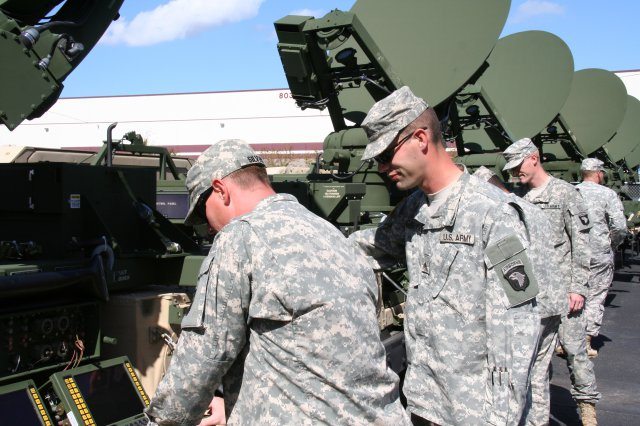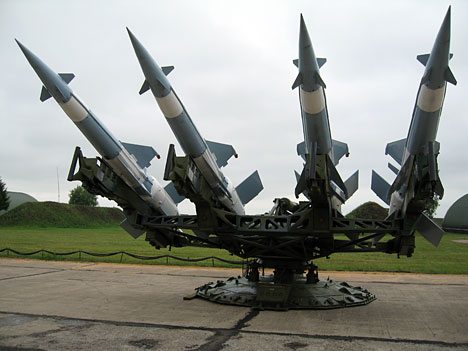As the Army looks for innovative solutions to slim its financial waistline, a new facility for the advanced version of its protected satellite terminal has consolidated production, training and fielding in one location in an effort to save millions of dollars.
“The training facility is co-located with the production facility to reduce our logistical footprint, overhead and reliability risk,” said Larry Raville, project lead for the Secure, Mobile, Anti-Jam, Reliable, Tactical-Terminal, known as SMART-T. “No longer does a team have to travel all over the world to field, ship and train these systems. It’s all done in one location.”
The first class of students, consisting of Soldiers from the 101st Airborne Division (Air Assault), attended the Advanced Extremely High Frequency, or AEHF, SMART-T New Equipment Training, or NET, at the new facility in Largo, Nov. 7-18. The facility’s grand opening ribbon cutting ceremony was held on Nov. 9, with the students from the 101st, members of the SMART-T team, and contractor leadership in attendance.
This is the first time in the Army’s history that a weapon system has had a NET/fielding facility embedded with a production plant, Raville said. The AEHF SMART-T facility is expected to yield more than $9 million in cost avoidance and cost savings by reducing the logistical footprint of training, fielding and upgrading the terminals.
Product Manager Satellite Communications, or PdM SATCOM, which manages SMART-T, also expects to see an increase in the terminals’ reliability rate, since all of the logistics are centrally located and issues can be more easily addressed, Raville said.
“Prior to the opening of this facility, if a failure occurred during training, we could be 900 miles away and it would take three or four days to get an asset out there, entailing huge shipping costs along with the loss of time,” said Mel Pointer, SMART-T Integrated Logistics Support manager. “Now we just have to walk across the street.”
SMART-T makes it possible for Soldiers to extend the range of their network in such a manner that communications cannot be jammed, detected, or intercepted. Soldiers can send text, data, voice and video communications beyond their area of operations without worrying that the information will fall into the hands of enemy forces.
Used at the brigade echelon and above, this satellite terminal mounts on High Mobility Multipurpose Wheeled Vehicles, or Humvees, and provides robust worldwide communications.
“SMART-T provides a means of [protected satellite] communications that isn’t available through other terminals,” said Sgt. David Carpenter, with the 101st, who was part of the first class at the new facility. “It may not be used quite as often, but when it is needed, no other terminal can do what it does. No other capability can replicate it.”
SMART-T enables the Soldier to extend communications in harsh environments without the risk of enemy interception or detection, increasing the safety of Soldiers on the battlefield. It provides tactical protected SATCOM for the close fight. When removed from the Humvee it is capable of stand-alone operation and can be airlifted via helicopter so it can get to a particular point on the battlefield in a hurry, establishing and maintaining a link quickly and reliably.
“Any time a commander needs protected, secure throughput for worldwide communications for current operations, this is his only capability,” Raville said.
The biggest difference between the legacy and the new AEHF satellite terminal upgrade is a fourfold increase in capacity and improved security features. AEHF terminals will increase satellite throughput with the extended data rate payload.
“Because SMART-T is protected, the systems have a lower bandwidth capability, but the upgrade gives us a higher bandwidth throughput by fourfold,” said LTC Gregory Coile, PdM for SATCOM, which is assigned to Project Manager Warfighter Information Network-Tactical, or PM WIN-T. “The advanced system also provides greater overall satellite access.”
Approximately 240 of the legacy systems have been fielded to date, plus an additional 60 AEHF SMART-Ts. Currently 39 new AEHF SMART-T terminals are in production and the remaining legacy systems will all be upgraded with the AEHF capability. By 2018 the total force is expected to have 411 of the AEHF SMART-Ts, with users including the Navy, Air Force, National Guard, Homeland Security, Missile Defense Authority, international partners and other special users.
While the Air Force is responsible for developing and maintaining military satellites, the Army develops, procures and fields the earth terminals such as the SMART-Ts. The two work closely together to ensure system interoperability. The Air Force is in the process of changing from the military’s legacy satellite constellation to the new AEHF satellite constellation, and it uses the Army’s version of the AEHF terminals for satellite testing, Coile said.
“The best benefits [of the new AEHF SMART-T] are the data rate, the bandwidth, being able to push more data and get more users on it, and its reliability,” said Sgt. Jesse Murphy of the 101st, who was part of the first training class at the facility and has worked with legacy SMART-Ts for four years. “It will be invaluable.”
Along with the NET, the facility will also offer delta training which provides experienced legacy SMART-T operators such as Murphy training on the AEHF version of the terminals. One of the biggest values of the facility is that roughly 75 percent of the training is hands-on, with only a minimum of classroom time involved, leaving the Soldier well-prepared upon deployment, Pointer said.
After Soldiers complete their training, the unit actually signs for the same equipment that they have trained on, and that equipment is then shipped to their new location. Prior to the opening of the facility, the SMART-T team would have to fly out to the unit several times to get them set up with the equipment, help with training and then inventory and sign over the equipment. The new facility allows the team to take care of everything in one spot.
The SMART-T NET/Fielding facility will also be a portal for data exchange and will be linked to Tobyhanna Army Depot in Pennsylvania, which will input valuable reset information into the facility’s database. The intent is to have a database that follows each SMART-T through all phases of its life cycle, from production to fielding, to upgrades to reset, with all of the data filed at a single source. This information is expected to save time, provide cost avoidance in maintenance and increase system reliability, Pointer said.
SMART-T is part of the WIN-T architecture and is compatible with both WIN-T Increments 1 and 2 and their corresponding equipment. Similar to a home Internet connection, WIN-T Increment 1, the Army’s current tactical network backbone, provides high-speed, high-capacity voice, data and video communications to units on the battlefield, at-the-halt or at-the-quick-halt. WIN-T Increment 2 will provide this network to military formations while on the move. In the spring of 2012 WIN-T Increment 2 will undergo its Initial Operational Test and Evaluation, or IOT&E, at White Sands Missile Range, N.M., and SMART-T will have a supporting role in that event.
PM WIN-T is assigned to Program Executive Office Command, Control, Communications-Tactical, or PEO C3T.
“The AEHF SMART-T is a new capability within the WIN-T construct and a chance to marry our capability in line with the ARFORGEN [Army Force Generation] cycle requirements,” Pointer said. “When a unit rotates out of the box, that whole unit gets reset, and we are making sure that when they move back onto the ready line, we have conformed to all of their requirements. Here we have our own resources to get that done. You just can’t beat the value of that.”











